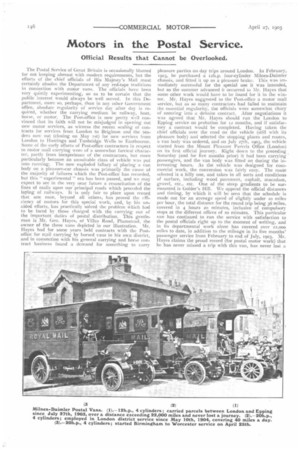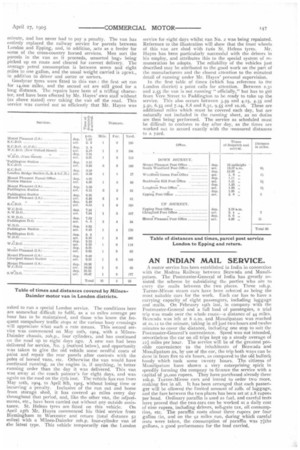Motors in the Postal Service.
Page 10

Page 11

If you've noticed an error in this article please click here to report it so we can fix it.
Official Results that Cannot be Overlooked.
The Postal Service of Great Britain is occasionally blamed for not keeping abreast with modern requirements, but the efforts of the chief officials of His Majesty's Mail must certainly absolve the Department of any red-tape traditions in connection with motor vans. The officials have been very quietly experimenting, so as to be certain that the public interest would always be well served. In this Department, more so, perhaps, than in any other Government office, absolute regularity of service day after day is required, whether the carrying medium be railway, boat, horse, or motor. The Post-office is now pretty well convinced that its faith will not be misjudged in opening out new motor services, as witness the recent sealing of contracts for services from London to Brighton and the tenders now out (closing on May 1st) for new services from London to Hastings and Tunbridge Wells to Eastbourne. Some of the early efforts of Post-office contractors in respect to motor mail carrying were of a somewhat farcical character, partly from inexperience of the contractors, but more particularly because an unsuitable class of vehicle was put into running. The now exploded fallacy of placing a van body on a pleasure-car chassis was primarily the cause of the majority of failures which the Post-office has recorded, but this " experimental " era has been passed, and we may expect to see in the very near future a resuscitation of the lines of mails upon our principal roads which preceded the laying of railways. It is only fair to place upon record that one man, beyond all others, has proved the efficiency of motors for this special work, and, by his unaided efforts, has practically solved the problem which had to be faced by those charged with the carrying out of the important duties of postal distribution. This gentleman is Mr. Geo. Hayes, of Villas Road, Plumstead, the owner of the three vans depicted in our illustration. Mr. Hayes had for some years held contracts with the Postoffice for mail carrying by horsed vans in his own district, and in connection with his general carrying and horse contract business found a demand for something to carry
pleasure parties on day trips around London. In February, 1903, he purchased a 12h.p. four-cylinder Milnes-Daimler chassis, and fitted it up as a pleasure brake. This was immediately successful for the special use it was intended, but as the summer advanced it occurred to Mr. Hayes that some other work would have to be found for it in the winter. Mr. Hayes suggested to the Post-office a motor mail service, but as so many contractors had failed to maintain the essential regularity, the officials were somewhat chary of entering into a definite contract. After negotiations it was agreed that Mr. Hayes should run the London to Epping service on probation for 12 months, and if satisfactory a contract would be completed. Having taken the chief officials over the road on the vehicle (still with its pleasure body) and selected the stopping places and routes, a van body was ordered, and on July 27th, 1933, the vehicle started from the Mount Pleasant Parcels Office (London) on its first official journey. Right down to the preceding , Saturday (and for rive months prior) it had been carrying inssengers, and the van body was fitted on during the intervening hours. As the vehicle was designed for cornmercial work, the conversion was fairly easy. The route selected is a hilly one, and takes in all sorts and conditions of surface, including wood pavement, asphalt, macadam, gravel, etc., etc. One of the steep gradients to be surmounted is Golder's Hill. We append the official distances and timing, by which it will be seen that the schedule is made out for an average speed of slightly under to miles per hour, the total distance for the round trip being 36 miles, covered in 4 hours 20 minutes, inclusive of compulsory stops at the different offices of zo minutes. This particular van has continued to run the service with satisfaction to the postal officials right up to the moment of writing, and in its departmental work alone has covered over 22,000 miles to date, in addition to the mileage in its five months' passenger service from February to end of July, 1903. Mr. Hayes claims the proud record (for postal motor work) that be has never missed a trip with this van, has never lost a
minute, and has never had to pay a penalty. The van has entirely replaced the railway service for parcels between London and Epping, and, in addition, acts as a feeder for some of the cross-country horsed services. Men sort the parcels in the van as it proceeds, unsorted bags being picked up en route and cleared for correct delivery. The average petrol consumption is between seven and eight miles to one gallon, and the usual weight carried is 25cw1., in addition to driver and sorter or sorters.
Goodyear tyres were fitted to this van : the first set ran for 24,000 miles, and the second set are still good for a long distance. The repairs have been of a trifling character, and have been effected by Mr. Hayes' own staff without (as above stated) ever taking the van off the road. This service was carried out so efficiently that Mr. Hayes was asked to run a special London service. The conditions here are somewhat difficult to fulfil, as a in miles average per hour has to he maintained, and those who know the frequent compulsory traffic stops at the various busy crossings will appreciate what such a rate means. This second service was commenced on May loth, 1904, with a ManesDaimler chassis, 20h.p., four cylinders, and has continued on the road up to eight days ago. A new van had been delivered for service, No. 3 (noticed below), and opportunity was taken to give the old vehicle some needful coats of paint and repair the rear panels after contests with the poles of horsed vans, etc. Otherwise the van would have continued running, as the engine is, if anything, in better running order than the day it was delivered. This van was away at the coach painter's for eight days, and was again on the road on the 17th inst. The vehicle has run from May loth, 1904, to April 8th, 1905, without losing time or incurring a penalty. Inclusive of the run out and home from storage shed, it has covered 40 miles every day throughout that period, and, like the other van, the adjusttnents, etc., have been carried out without any outside assis tance. St. Helens tyres are fitted on this vehicle. On April 25th Mr. Hayes commenced his third service from Birmingham to Worcester and return (total distance 52 miles) with a Milnes-Daimler 2oh.p. four-cylinder van of the latest type. This vehicle temporarily ran the London service for eight days whilst van No. 2 was being repainted. Reference to the illustration will show that the front wheels of this van are shod with twin St. Helens tyres. Mr. Hayes has been particularly successful with the drivers in his employ, and attributes this to the special system of remuneration he adopts. The reliability of the vehicles just described may be attributed to the good work on the part of the manufacturers and the closest attention to the minutest detail of running under Mr. Hayes' personal supervision.
In the first table of times (which has reference to the London district) a point calls for attention, Between 2.31 arid 2.55 the van is not running " officially," but has to get from Vert: Street to Paddington to be ready to take up the service. This also occurs between 3.59 and 4.25, 4.35 and 5.50, 6.55 and 7.24, 8.8 and 8.32, 9.55 and 10.26. These are additional miles which must be covered each day, but are naturally not included in the running sheet, as no duties are then being performed. The service as scheduled must be difficult to conform to day after day, as the times are worked out to accord exactly with the :Treasured distances to a yard.
AN INDIAN MAIL SERVICE.
A motor service has been established in India in connection with the Madras Railway between Bezwada and Masulipatam. The Postmaster-General of India has greatly assisted the scheme by subsidising the parties who are to carry the mails between the two places. Three mh.p. Turner-Miesse steam cars have been seleoed as being the most suitable cars for the work. Each car has to have a carrying capacity of eight passengers, including luggage and mails. On February 19th last, in company with the Postmaster-General and a full load of passengers, a trial trip was made over the whole route-a distance of 44 miles. llezwada was left at 8 a.m. and Masulipatam was reached at 10.12 to the minute, taking in all just two hours and twelve minutes to cover the distance, including one stop to suit the Postmaster-General's convenience. Speed was not intended, nevertheless the car on all trips kept up a steady average of 2 2 l• miles per hour. The service will be of the greatest possible convenience to the inhabitants of Bezwada and Masulipatam as, by use of the car, the trip both ways can be done in from five to six hours, as compared to the old bullock bandy which took some twenty hours. The citizens of Masulipatam have shown a very enterprising spirit in speedily forming the company to firance the service with a capital of 30,000 rupees. They have purchased already three roh.p. Turner-Miesse cars and intend to order two more, making five in all. It has been arranged that each passenger will be allowed the limited amount of 2211): of luggage, and the fare between the two places has been set at 2.8 rupees per head. Ordinary paraffin is used as fuel, and careful tests have proved that the two cars can be worked at a daily cost of nine rupees, including drivers, toll-gate tax, oil consumption, etc. The paraffin costs about three rupees per four gallon ein, and on the 92 miles run, during which careful tests were taken, the consumption of paraffin was 711,ths gallons, a good performance for the load carried.




















